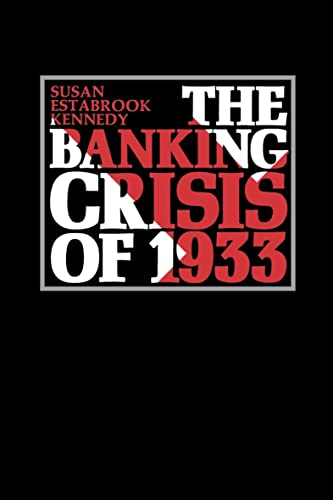The Banking Crisis of 1933
Susan Estabrook Kennedy
BOOK REVIEW

The dust of the Great Depression settled like a heavy fog over America, shrouded in confusion and despair. In the midst of this turmoil, The Banking Crisis of 1933 emerges as a piercing analysis that delves deep into the catastrophic financial upheavals of that era. Authored by Susan Estabrook Kennedy, this book is not merely a recounting of historical events; it is a clarion call that resonates through time, forcing you to confront the fragility of financial institutions and the human suffering they can unleash.
As you turn the pages of Kennedy's thorough research, you'll find yourself swept into a world where ordinary citizens faced extraordinary challenges. The banking collapse of 1933 was no ordinary glitch in the economy; it was a tremor that shook the foundations of American society. Kennedy meticulously lays out the events leading to the bank failures, the panic that ensued, and the lifeline offered by the government through the Emergency Banking Act. This wasn't just a mere moment in history-it was a crucible that forged the regulatory landscape of modern banking and shaped America's financial system in ways that still echo today.
Readers have lauded Kennedy's ability to breathe life into the cold statistics of financial failure, allowing you to see the faces behind the numbers. Critics, however, point out that some sections feel dense with economic jargon, potentially alienating readers unfamiliar with financial terminology. But to dismiss this work for its intricacies would be a mistake; Kennedy's depth of knowledge is what transforms this narrative from dry history into an urgent conversation about accountability, governance, and the power of the financial elite.
The emotional gravity of this historical account sometimes hits harder than any fictional drama. As you immerse yourself, you witness the desperation of families losing their homes, the anguish of the unemployed, and the despair of a nation on the brink of collapse. You cannot help but feel a sense of solidarity with those who lived through this era. Their struggles compel you to reflect on today's economic system and the inherent vulnerabilities that persist, making you question the very structures that underpin our financial well-being.
Kennedy's examination does not shy away from the consequences of inaction, urging you to confront your own perceptions of economic resilience. In a world where financial crises seem cyclical, she ignites a flame of urgency-this could happen again. Historical amnesia is a dangerous game.
Discussions around The Banking Crisis of 1933 have sparked controversy, too. Some argue that Kennedy's analysis leaves out critical perspectives on the role of individual banks or the long-term consequences of government interventions. Yet, these critiques only serve to enhance the discourse, revealing the complex layers of a multifaceted issue. This book is not simply for enthusiasts of economic history; it is essential for anyone hoping to understand the current financial landscape marred by echoes of the past.
In the end, picking up Kennedy's work isn't just an act of reading; it's an invitation to engage with the very fabric of our collective economic narrative. It urges you to confront uncomfortable truths and consider the stakes involved-not only for those who experienced the despair of 1933 but for all of us navigating today's tumultuous financial waters. The gripping tale of resilience, mismanagement, and the quest for stability within its pages will leave an indelible mark on your understanding of history and its lasting impact. Will you let the cautionary tales of our past shape your present? 📉
📖 The Banking Crisis of 1933
✍ by Susan Estabrook Kennedy
🧾 279 pages
2021
#banking #crisis #1933 #susan #estabrook #kennedy #SusanEstabrookKennedy